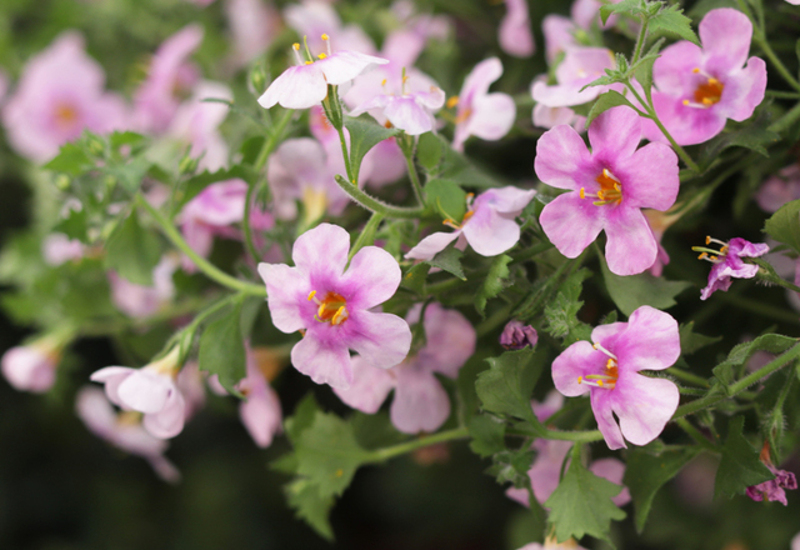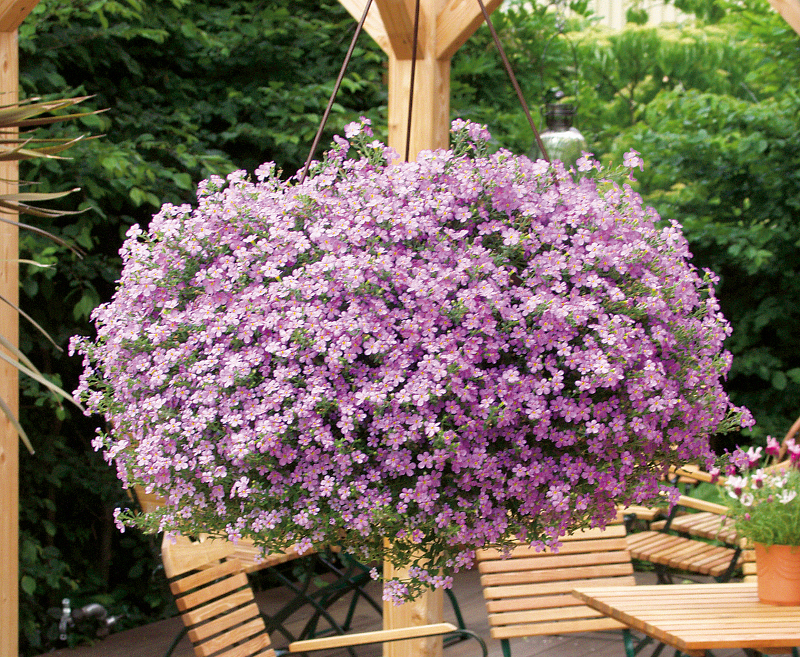Bacopa (Sutera cordata) is an annual plant that blooms from spring to fall. Originating from the rainier parts of South Africa, Bacopa is not in the genus Bacopa at all, but in the genus Sutera. Commonly referred to as Sutera, it has small, white, blue, or pink five-petaled flowers, and green foliage.
Hardy in USDA zones 9-11, this plant likes full sun to some partial shade. Bacopa can grow 3 to 12 inches tall, 10 to 36 inches wide, and cascade up to 4 feet long. Gardeners love to use Bacopa for groundcover, as a container spiller, and to attract butterflies.

Planting Bacopa
Plant Bacopa in late spring after the threat of frost has passed. Choose a location that will get full sun with some afternoon shade. When planted in the garden, space plants 10-12 inches apart. Container Sutera can be planted closer together.
Prior to planting, amend soil with compost or organic matter. Make sure the soil is well drained. Water well after planting.
Watering Bacopa
This fairly low-maintenance plant requires regular watering for continuous blooming. When drought-stressed, Bacopa flowers and buds will drop off. The soil should be kept moist, at least an inch below the surface. It is best to water evenly and avoid overwatering.
During hot spells, daily water may be needed. Applying a layer of mulch around the plants will help to conserve water in the soil. Do not allow the plant to sit in standing water as this can lead to root rot.

Fertilizing Bacopa
Routine fertilizing will keep your Bacopa blooming all season long. Use a water-soluble 10-10-10 fertilizer and follow package instructions. Fertilize every 2-3 weeks for landscape plants. Container plants will need to be fertilized every 1-2 weeks.
Pruning Bacopa
Bacopa plants are considered self-cleaning, which means deadheading is not necessary. If you like, you can remove spent flowers to speed up blooming. Typically, this would be done on younger plants. It is a good idea to occasionally trim back the plant 5-6 inches to clean it up and promote new growth. This can help promote good air circulation, healthy stems, and healthy roots.

Caring For Bacopa in Pots
Bacopa can grow 3 to 12 inches tall, 10 to 36 inches wide, and cascade up to 4 feet long. Choose a location that will get full to partial sun and is protected from windy conditions. Plant in a large container with drainage holes and use a high quality, well-draining potting soil. This plant will quickly stop blooming if allowed to dry out.
It is best to water regularly as soon as the soil dries up. Saturate the soil well each time you water. Fertilize container Bacopa every 1-2 weeks.
Winter Care for Bacopa
Typically grown as an annual in USDA zones 9-11, Bacopa is enjoyed during the warm flowering season. This plant will die off with the first frost. Container-grown Sutera can be brought indoors to overwinter. If given enough light, they can continue to bloom all winter long.
Bacopa Classification
| Kingdom: | Plantae |
| Clade: | Tracheophytes |
| Clade: | Angiosperms |
| Clade: | Asterids |
| Clade: | Asterids |
| Order: | Lamiales |
| Family: | Scrophulariaceae |
| Genus: | Chaenostoma |
| Species: | C. cordatum |
Bacopa Plants For Sale
Common Bacopa Care Questions
Is Sutera The Same As Bacopa?
Sutera Cordata and Bacopa are the same plants, a lush, deep green, trailing foliage with tiny white to mauve blooms and is used as a spiller in many flower pot or hanging basket arrangements.
Can You Divide Bacopa?
The best way to propagate Bacopa is to take cuttings. You can cut a stem, just below a set of leaves, remove the leaves, dip it in some rooting hormone, and stick it in the soil. In a few weeks, it should root and begin growing. If there are flowers, large or damaged leaves, and you can easily remove them, they should be removed so the Bacopa will concentrate its energy on developing roots, instead.
Is Bacopa Annual Or Perennial?
While bacopa is grown as a perennial in zones 9-11, in other zones, they are planted frequently and loved as an annual.
Does Bacopa Like Sun Or Shade?
Bacopa does best in full sun, though it will also do well in filtered light shade.
Why Is My Bacopa Turning Brown?
Most commonly, bacopa turns brown from intense sunlight and may benefit from being a bit protected from direct sun during the hottest part of the day and may benefit from watering twice a day on the hottest of summer days.
Why Do Bacopa Leaves Turn Yellow?
Yellow leaves on bacopa can be indicative of several issues. Most commonly under-watering, an iron deficiency in the soil (or a pH level that is too high and doesn't allow absorption of the iron.) Yellowing leaves may also mean there are spider mites or aphids present.
Have a question about Bacopa? Fill out the form below and we will try and get back to your question as soon as possible. We may even feature your question on this article to help other gardeners!
 |
Author Chris Link - Published 09-08-2021 |
